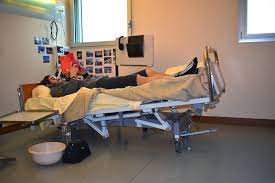Bed Rest Benefits: Helping You Recover Faster and Manage Health Conditions
Bed rest is a form of medical treatment where a patient is advised to remain in bed for an extended period to promote healing, alleviate symptoms, or prevent complications. This treatment is commonly prescribed for various medical conditions such as pregnancy complications, post-surgery recovery, and muscular or skeletal injuries. Bed rest usually entails lying down or sitting up in bed for most of the day with little to no physical activity. The duration of bed rest can vary depending on the condition and the patient’s response to treatment. Although bed rest may seem like a comfortable option, it can also have adverse effects on physical and mental health, such as muscle weakness, bone loss, and depression. Therefore, it is crucial to understand the benefits and risks of bed rest and follow the healthcare provider’s instructions carefully. Please keep reading for details on the following topics:
Indications for bed rest
Risks of bed rest
Reasons for bed rest
Side effects of bed rest
Ways to cope with movement restrictions
How to deal with discomforts from bed rest
How does bed rest affect postpartum

Types of Bed Rest
- Partial Bed Rest:
- The woman is encouraged to rest for most of the day but can still engage in light activities, such as short walks to the bathroom, cooking, or light household chores.
- Strict Bed Rest:
- Complete rest is required, meaning the woman must remain in bed for the majority of the day and avoid any physical activity except for what is necessary, such as bathroom visits.
Benefits of Bed Rest
- Reduces Physical Stress: Resting helps alleviate strain on the body and may improve circulation, especially to the uterus and placenta.
- Prevents Further Complications: For conditions like high blood pressure or placental issues, bed rest can prevent worsening symptoms.
- Improves Fetal Outcomes: Bed rest may reduce the risk of preterm labor or promote better fetal growth in certain conditions.
INDICATIONS FOR BEDREST
High blood pressure, such as preeclampsia or eclampsia
Cervical changes, such as incompetent cervix or cervical effacement
Vaginal bleeding
History of pregnancy loss, stillbirth, or premature birth
Placenta complications, such as placental abruption, placenta previa
RISKS OF BEDREST
A blood clot in a deep vein, such as a vein in your leg (venous thromboembolism)
Decreased bone mass (bone demineralization)
Musculoskeletal and cardiovascular deconditioning
Maternal weight loss or weight gain
Stress due to self-blame, childcare issues, and concerns about job loss or finances
An increased risk of depression and anxiety
REASONS FOR BEDREST
Bed rest is used to give the body it’s best chance to normalize. Bed rest will be used with women who have conditions related to high blood pressure in order to decrease stress on the heart and lower blood pressure.
- Risk of Preterm Labor:
- If a woman is at risk of delivering before 37 weeks, bed rest might help by reducing stress on the cervix and uterus.
- High Blood Pressure or Preeclampsia:
- If a woman develops high blood pressure or preeclampsia (a pregnancy-related high blood pressure condition), bed rest can help lower blood pressure and improve blood flow to the baby.
- Placenta Previa:
- In cases where the placenta partially or completely covers the cervix, rest may be advised to reduce the risk of bleeding or complications.
- Multiple Pregnancy (Twins or More):
- Women carrying multiples may be at higher risk for preterm labor, and bed rest might be recommended to help ensure the pregnancy progresses to term.
- Fetal Growth Restriction:
- If the baby is not growing at the expected rate, bed rest may improve blood flow to the placenta, helping the baby receive more nutrients and oxygen.
- Cervical Insufficiency:
- If the cervix begins to shorten or open too early (known as incompetent cervix), bed rest may help prevent further dilation and premature labor.
- Severe Morning Sickness or Hyperemesis Gravidarum:
- In cases of severe nausea and vomiting, bed rest may be recommended to help the woman rest and manage her symptoms.
- Other Complications:
- Conditions like vaginal bleeding, dehydration, or certain infections might also warrant a period of bed rest for the safety of both the mother and baby.
- Work, activity, lifting, or exercise may worsen or provoke certain situations, so bed rest may be prescribed to reduce vaginal bleeding or decrease the chance of premature labor.
- Bed rest may also be necessary to help increase blood flow to the placenta thus improve the circulation of blood in the uterus and offers extra nourishment and oxygen to the baby.
- To allow the pelvis to rest

SIDE EFFECTS OF BEDREST
While bed rest can be beneficial in some cases, it can also have risks if not managed properly:
-
Physical Deconditioning:
- Prolonged bed rest can lead to weakened muscles, reduced circulation, and other physical challenges. This can make it harder to recover after childbirth.
- Reduction in the bone mass
-
Blood Clots:
- Spending long periods of time in bed can increase the risk of developing blood clots (deep vein thrombosis or DVT), particularly in the legs. This is especially a concern if mobility is limited for an extended period.
-
Mental and Emotional Effects:
- Extended bed rest can lead to feelings of isolation, frustration, anxiety, and depression due to physical limitations and the social withdrawal that might occur.
-
Risk of Muscle and Joint Stiffness:
- Being immobile for extended periods can cause stiffness and discomfort in the muscles and joints.
- Stress
- Financial or job loss
- Feel helpless
- See the same people every day (nurses, doctor, janitor), routine or activities (vital signs, using a bedpan, sponge baths, same medication)
- Don’t like the bed(uncomfortable), bathroom (have to share it), curtains (no privacy)

COPING WITH MOVEMENT RESTRICTIONS
If bed rest is prescribed, here are some tips to manage it effectively:
- Stay Active Within Limits:
- If partial bed rest is recommended, ensure you stay active within the guidelines provided by your healthcare provider. For example, doing simple stretches or moving your legs frequently can help maintain circulation.
- Keep Yourself Comfortable:
- Use pillows and cushions to support your back, legs, and abdomen while resting. Ensure you’re comfortable enough to relax and stay in bed without straining.
- Monitor Your Mental Health:
- Bed rest can be isolating, so stay in touch with loved ones and find ways to stay entertained and connected, such as reading, watching movies, or using social media.
- Follow Your Healthcare Provider’s Instructions:
- Strict adherence to the recommended bed rest duration and restrictions is crucial. If you’re unsure about any activity, always check with your healthcare provider.
- Stay Hydrated and Nourished:
- While resting, it’s important to continue to eat healthy foods and drink plenty of water to stay hydrated.
- Take Care of Your Circulation:
- If you’re on strict bed rest, make sure to move your legs and feet regularly to prevent blood clots. Consider using compression socks if recommended by your doctor.
- Mental and Emotional Support:
- Take time to engage in activities that help you relax mentally, such as mindfulness, meditation, or journaling. Reach out to support groups or loved ones to maintain your emotional well-being.
- Get organized. Make sure everything you need for the day is within reach.
- Beat boredom. Email, text or write letters. Organize photos or start a scrapbook. Shop for baby goods online. Read your way through the best-seller list. Learn relaxation techniques for labor. Make plans for baby. Going home. Prepare room.
- Seek support. To maintain a positive attitude, connect with other moms-to-be on bed rest or those who have been through it. Check for support groups online. If you’re having trouble coping, ask your health care provider or mental health provider for additional help.
- Expect emotional challenges. Share your fears, hopes and concerns with your partner. Let each other vent. If sex isn’t allowed, look for other ways to maintain intimacy.
- Stay limber. Stretch your legs and ankles or do gentle exercises whilst in bed to help prevent blood clots and keep your muscles strong.
- Accept help. When friends and loved ones ask what they can do, be prepared with a list of tasks
- Start a journal. Putting your thoughts to paper can be therapeutic and imagine sharing what you were thinking and going through with your loved ones one day. Whether you share with them or keep it as a private journal, these days and weeks will go by faster than you think. It can be fun to look back and remember how far you have come.
- Avoid lifting or any strenuous activity.
- Monitor what you eat. Be sure you’re following a healthy pregnancy diet. To keep heartburn at bay, try to eat many small meals during the day instead of three big ones. Dried fruit (which is also chock-full of vitamins) will help keep you regular.
- Stay hydrated! You’re eating and drinking for two. And while it’s easy to remember to drink water when you’re being active, it’s easy to forget to drink water when you’re not. Getting enough fluids helps minimize swelling and constipation, especially when you’re moving less.
- Keep comfortable. If you are confined to bed for most of the day, maximize blood flow to your uterus by lying on your side, not your back, and change sides every hour or so to lessen body aches and prevent skin irritations. Put a pillow under your head, a body pillow under your belly and between your knees and perhaps a pillow behind you, if that helps you to balance. Sitting up slightly in bed (especially after eating) helps prevent heartburn.
HOW CAN I DEAL WITH BED REST DISCOMFORTS?
Bed rest will tend to cause your muscles to lose tone and make some of your joints ache. Lying down for long periods of time can also reduce your blood circulation. Changing from side to side will help stimulate your muscles and relieve pressure.
Exercise is important for your blood circulation, but make sure that you visit with your health care provider before you begin any exercises.
Below are common exercises that may be used:
Squeezing stress balls
Pressing your hands and feet against the bed
Turning your arms and feet in circles
Tensing or tightening your arm and leg muscles
Avoid using your abdominal muscles when you are stretching or exercising. Again, consult with your healthcare provider about the best ways for you to get exercise in your situation.
In addition to feeling tired and isolated, you may experience muscle and joint pain, backache and dizziness. A physical therapist or a massage therapist may be able to help you deal with these conditions

CAN BED REST AFFECT MY POSTPARTUM RECOVERY?
This depends on how long you have been on prescribed bed rest. If you have been inactive for a long time, you may experience muscle weakness and a lack of energy after your delivery. In those first few weeks, try to rest or sleep when your baby sleeps, eat healthy food and snacks and delegate chores so that you can recover.
When to Seek Medical Advice
If you’re on bed rest and experience any of the following, it’s important to contact your healthcare provider immediately:
- Severe pain or cramping.
- Heavy bleeding.
- Shortness of breath or chest pain.
- Swelling or redness in one leg (possible sign of blood clot).
- Signs of depression or anxiety.
Your healthcare provider will provide guidance on the duration of bed rest and any modifications needed based on your individual health and pregnancy condition.
Disclaimer: The information provided in this content is for general informational purposes only. It is not intended as medical or healthcare advice, diagnosis, or treatment. Always seek the advice of a qualified healthcare professional with any questions you may have regarding a medical condition or healthcare decisions.

